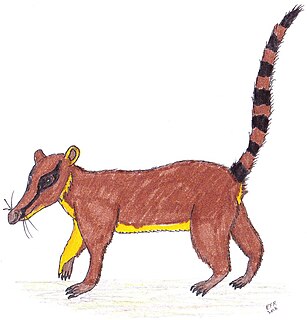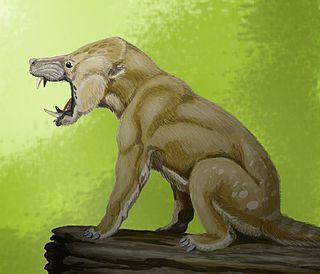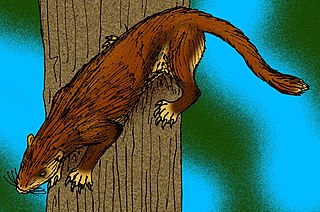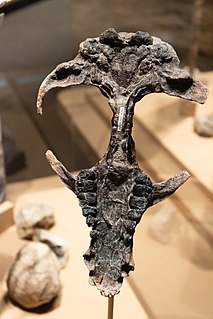Related Research Articles

Catopsalis is a genus of extinct mammal from the Paleocene of North America. This animal was a relatively large member of the extinct order of Multituberculata. Most Multituberculates were much smaller.
Sphenopsalis is a genus of extinct mammal from the Paleocene of Central Asia. It was a member of the extinct order Multituberculata, and lies within the suborder Cimolodonta and the superfamily Taeniolabidoidea. The genus was named by William Diller Matthew, W. Granger and George Gaylord Simpson in 1928.

Taeniolabis is a genus of extinct multituberculate mammal from the Paleocene of North America.
Neoplagiaulax is a mammal genus from the Paleocene of Europe and North America. In the case of the latter continent, there may possibly be some slightly earlier, Upper Cretaceous material too. It existed in the age immediately following the extinction of the last dinosaurs. This animal was a member of the extinct order Multituberculata, lying within the suborder Cimolodonta and family Neoplagiaulacidae.
Kimbetohia is a genus of mammal belonging to the extinct order Multituberculata. It lived from the Upper Cretaceous to the Paleocene in the United States.
Eucosmodon is a genus of extinct mammal from the Paleocene of North America. It is a member of the extinct order of Multituberculata within the suborder of Cimolodonta, and the family Eucosmodontidae. This genus has partly also been known as Neoplagiaulax. All known fossils of this small mammal are restricted to teeth.
Microcosmodon is a mammal genus from the Paleocene of North America. It was a member of the extinct order Multituberculata, and lies within the suborder Cimolodonta and family Microcosmodontidae. The genus Microcosmodon was named by G.L. Jepsen in 1930.

Chriacus was a genus of placental mammals that lived in what is now North America during the Paleocene epoch and died out after the early Eocene. In life, members of the genus would have looked something like a kinkajou or binturong, though they were not closely related to any living mammal. Well preserved fossils allow clear information on what they looked like. They were about 1 metre (3.3 ft) long including a long, robust tail, which may or may not have been prehensile. Other features include a light build, weighing approximately 7 kg (15 lb), and many adaptations typical of animals that live in trees. These include walking on the soles of their five-toed feet, and having long, curved, compressed claws. The powerfully built limbs had flexible joints, especially the ankles, an adaptation that allows an animal to turn its hind feet behind it, like modern tree squirrels, in order to climb downward. They were probably omnivores, eating fruit, eggs, insects and small mammals.

Arctocyonidae has been defined as an extinct family of unspecialized, primitive mammals with more than 20 genera. Animals assigned to this family were most abundant during the Paleocene, but extant from the late Cretaceous to the early Eocene . Like most early mammals, their actual relationships are very difficult to resolve. No Paleocene fossil has been unambiguously assigned to any living order of placental mammals, and many genera resemble each other: generalized robust, not very agile animals with long tails and all-purpose chewing teeth, living in warm closed-canopy forests with many niches left vacant by the K-T extinction.
The Puercan North American Stage on the geologic timescale is the North American faunal stage according to the North American Land Mammal Ages chronology (NALMA), spanning the interval from 66,000,000 to 63,300,000 years BP lasting 2.7 million years.
The Evanston Formation is a geological formation in Wyoming whose strata date back to the Late Cretaceous. Dinosaur remains are among the fossils that have been recovered from the formation. The fossil formation also has the remains of prehistoric mammals from the Paleocene epoch. Mammal fossils have been found in Paleocene rocks here too.
Oxyacodon is an extinct genus of condylarth of the family Periptychidae endemic to North America during the Early Paleocene living from 66–63.3 mya, existing for approximately 2.7 million years.

The Nacimiento Formation is a sedimentary rock formation found in the San Juan Basin of western New Mexico. It has an age of 61 to 65.7 million years, corresponding to the early and middle Paleocene. The formation has yielded an abundance of fossils from shortly after the Cretaceous-Paleogene extinction event that provide clues to the recovery and diversification of mammals following the extinction event.

Hyopsodontidae is an extinct family of unspecialized, primitive mammals from the order Condylarthra, living from the Paleocene to the Eocene in North America and Eurasia. Condylarthra is now thought to be a wastebasket taxon; hyopsodontids have occasionally been speculated to be related to Afrotheria, while the most recent consensus appears to be as part of Perissodactyla, and in particular closely related to horses.

Eoconodon is an extinct genus of triisodontid mesonychid that existed during the early Paleocene of North America. Characteristics of the genus include massive jaws, blunt builds, and strong canine teeth.
Chacopterygus is an extinct genus of cimolestid mammal which existed in New Mexico, during the early Paleocene. Its fossils have been recovered from the Nacimiento Formation, San Juan Basin, New Mexico. It was first named by Thomas E. Williamson, Anne Weil and Barbara Standhardt in 2011 and the type species is Chacopterygus minutus.
Betonnia is an extinct genus of cimolestid mammal which existed in New Mexico, during the early Paleocene. Its fossils have been recovered from the Nacimiento Formation, San Juan Basin, New Mexico. It was first named by Thomas E. Williamson, Anne Weil and Barbara Standhardt in 2011 and the type species is Betonnia tsosia.
This article records new taxa of fossil mammals of every kind that have been described during the year 2011, as well as other significant discoveries and events related to paleontology of mammals that occurred in the year 2011.
Schowalteria is a genus of extinct mammal from the Cretaceous of Canada. It is the earliest known representative of Taeniodonta, a specialised lineage of non-placental eutherian mammals otherwise found in Paleocene and Eocene deposits. It is notable for its large size, being among the largest of Mesozoic mammals, as well as its speciation towards herbivory, which in some respects exceeds that of its later relatives.
Lambdopsalidae is a family of extinct multituberculate mammals from the Late Paleocene of Asia. They are part of Taeniolabidoidea, a clade otherwise present in the Early Paleocene of North America; lambdopsalids, therefore, probably evolved from a single radiation that spread into Asia from North America in the mid-Paleocene or earlier. They are represented by the genus Lambdopsalis, Sphenopsalis and Prionessus.
References
- ↑ Thomas E. Williamson and Anne Weil (2011). "A new early Paleocene (Puercan) hyopsodontid "condylarth" from New Mexico" (PDF). Acta Palaeontologica Polonica. 56 (2): 247–255. doi: 10.4202/app.2009.0147 . S2CID 54639945.